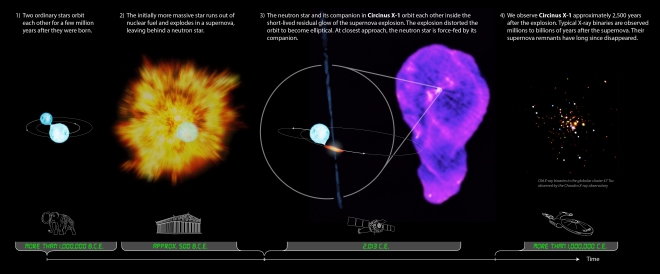4 December 2013
The youngest pair of stars to emerge from a supernova, dancing around each other as the neutron star cannibalises its partner, has been identified by an international collaboration involving Professor Rob Fender of Oxford University.
The pair began life as giant stars peacefully orbiting each other, one slightly heavier than its companion. Over time, the heavier star became unstable and around 4,600 years ago it went supernova, collapsing under its own gravity in a huge explosion. In most cases, the force of the explosion sends the companion star hurtling through space, breaking the pair up – but not in this system, called Circinus X-1.
'The companion star probably absorbed a lot of the material from the larger star before the explosion, growing into a supergiant so heavy that it was barely moved by the blast,' said Professor Fender of Oxford University's Department of Physics, co-author of the latest study. 'Meanwhile, the supernova forced the remains of the larger star, around the mass of two suns, into a super-dense neutron star no bigger than a city.
'This is an incredibly rare scenario, and we've never seen a system like this so soon after supernova before – 4,600 years might not sound too young, but we're talking about systems that typically take millions of years to mature.'
At this early stage, the stars scream past each other in long, erratic cigar-shaped orbits. As they pass each other every 17 days, the neutron star sucks great masses of material from its partner and spits them out of its poles at near-light speed. Such systems are called X-ray binaries because X-ray and radio waves are given off by the super-fast jets of material spat out of the neutron star.
'This is a truly spectacular time to see the system, when it's so young and turbulent,' said Professor Fender. 'The orbits evolve as the neutron star consumes its companion, since the differences in mass are forever changing. The orbit has already changed considerably in the past seventy years alone. We're used to seeing change over hundreds of thousands of years, so it's incredible to see a system which is evolving over mere decades.'
The extreme evolution of Circinus X-1 is down to its age, and the researchers proved that it's the youngest X-ray binary in the galaxy at less than 4,600 years old. Until this latest study, published in The Astrophysical Journal, the youngest binary system spotted in the galaxy was SS433 which could be anywhere between 10,000 and 100,000 years old.
'We only see the wild, unstable orbits in the first few thousand years before things stabilise after the initial supernova,' said Professor Fender. 'We never had the opportunity to see this in SS433, as it had already stabilised by the time we first observed it. Circinus X-1 provides us an exciting opportunity to look at the early evolution of X-ray binaries, right after their birth in a supernova.'
When stars explode in a supernova, they can send out immense shockwaves which sweep up material and drag it through space at up to 10% of the speed of light. These expanding structures, called supernova remnants, give off X-ray and radio waves as the swept-up material hurtles through space.
'By comparing our radio wave observations with the X-ray data, we showed that the radio waves coming from Circinus X-1 were from the supernova remnant,' says Professor Fender, who led the radio wave element of the study. 'People previously thought that the radio signals might be produced by the high-speed jets coming from the neutron star's poles, but these only account for some of the radiation.'
'Another fascinating thing we found is that the neutron star has an incredibly low magnetic field for its age. As neutron stars suck in more material, their magnetic fields are pushed down over billions of years. Yet the neutron star in Circinus X-1 already has a low magnetic field, suggesting that it was either born that way or that the field was quickly suppressed by accreted material. It would normally take at least a million years for accreted material to push the field down to such a level, so we're definitely seeing something special here.'
The research was led by Dr Sebastian Heinz at the University of Wisconsin-Madison and used data from the NASA Chandra X-ray Observatory and the Australia Telescope Compact Array.
Source:
http://www.ox.ac.uk/media/news_releases_for_journalists/131204.html















